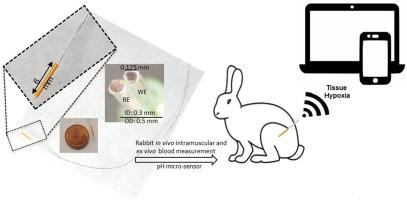Talanta ( IF 6.1 ) Pub Date : 2020-12-25 , DOI: 10.1016/j.talanta.2020.122045 Samuel Dulay , Lourdes Rivas , Sandrine Miserere , Laura Pla , Sergio Berdún , Johanna Parra , Elisenda Eixarch , Eduard Gratacós , Míriam Illa , Mònica Mir , Josep Samitier

|
Hypoxia is a common medical problem, sometimes difficult to detect and caused by different situations. Control of hypoxia is of great medical importance and early detection is essential to prevent life threatening complications. However, the few current methods are invasive, expensive, and risky. Thus, the development of reliable and accurate sensors for the continuous monitoring of hypoxia is of vital importance for clinical monitoring. Herein, we report an implantable sensor to address these needs. The developed device is a low-cost, miniaturised implantable electrochemical sensor for monitoring hypoxia in tissue by means of pH detection. This technology is based on protonation/deprotonation of polypyrrole conductive polymer. The sensor was optimized in vitro and tested in vivo intramuscularly and ex vivo in blood in adult rabbits with respiration-induced hypoxia and correlated with the standard device ePOCTM.
The sensor demonstrated excellent sensitivity and reproducibility; 46.4 ± 0.4 mV/pH in the pH range of 4–9 and the selectivity coefficient exhibited low interference activity in vitro. The device was linear (R2 = 0.925) with a low dispersion of the values (n = 11) with a cut-off of 7.1 for hypoxia in vivo and ex vivo. Statistics with one-way ANOVA (α = 0.05), shows statistical differences between hypoxia and normoxia states and the good performance of the pH sensor, which demonstrated good agreement with the standard device. The sensor was stable and functional after 18 months.
The excellent results demonstrated the feasibility of the sensors in real-time monitoring of intramuscular tissue and blood for medical applications.
中文翻译:

基于组织酸中毒的微植入式缺氧传感器的体内监测
缺氧是一种常见的医学问题,有时难以发现,并且是由不同情况引起的。控制缺氧具有重要的医学意义,及早发现对于预防危及生命的并发症至关重要。然而,目前的几种方法是侵入性的,昂贵的且有风险的。因此,开发用于连续缺氧监测的可靠,准确的传感器对于临床监测至关重要。在此,我们报告了一种可植入传感器,可以满足这些需求。开发的设备是一种低成本的微型植入式电化学传感器,用于通过pH检测来监视组织中的缺氧。该技术基于聚吡咯导电聚合物的质子化/去质子化。该传感器在体外进行了优化,并在体内进行了测试呼吸诱发的缺氧的成年兔体内肌肉内和离体血液中的含量,并与标准装置ePOC TM相关。
该传感器具有出色的灵敏度和可重复性;在4-9的pH范围内为46.4±0.4 mV / pH,选择性系数在体外具有较低的干扰活性。该装置是线性的(R 2 = 0.925),其值的低分散性(n = 11)和体内和体外缺氧的截止值为7.1 。单向方差分析(α= 0.05)的统计数据显示了低氧和常氧状态之间的统计差异,以及pH传感器的良好性能,这表明与标准设备具有良好的一致性。18个月后,传感器稳定且功能正常。
优异的结果证明了传感器在医学应用中实时监测肌内组织和血液的可行性。


























 京公网安备 11010802027423号
京公网安备 11010802027423号